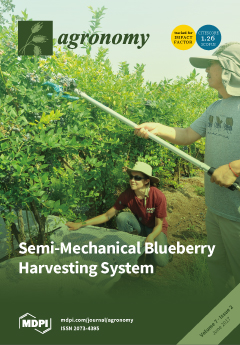Elevated carbon dioxide (eCO
2) stimulates wheat grain yield, but simultaneously reduces protein/nitrogen (N) concentration. Also, other essential nutrients are subject to change. This study is a synthesis of wheat experiments with eCO
2, estimating the effects on N, minerals (B,
[...] Read more.
Elevated carbon dioxide (eCO
2) stimulates wheat grain yield, but simultaneously reduces protein/nitrogen (N) concentration. Also, other essential nutrients are subject to change. This study is a synthesis of wheat experiments with eCO
2, estimating the effects on N, minerals (B, Ca, Cd, Fe, K, Mg, Mn, Na, P, S, Zn), and starch. The analysis was performed by (i) deriving response functions to assess the gradual change in element concentration with increasing CO
2 concentration, (ii) meta-analysis to test the average magnitude and significance of observed effects, and (iii) relating CO
2 effects on minerals to effects on N and grain yield. Responses ranged from zero to strong negative effects of eCO
2 on mineral concentration, with the largest reductions for the nutritionally important elements of N, Fe, S, Zn, and Mg. Together with the positive but small and non-significant effect on starch concentration, the large variation in effects suggests that CO
2-induced responses cannot be explained only by a simple dilution model. To explain the observed pattern, uptake and transport mechanisms may have to be considered, along with the link of different elements to N uptake. Our study shows that eCO
2 has a significant effect on wheat grain stoichiometry, with implications for human nutrition in a world of rising CO
2.
Full article





